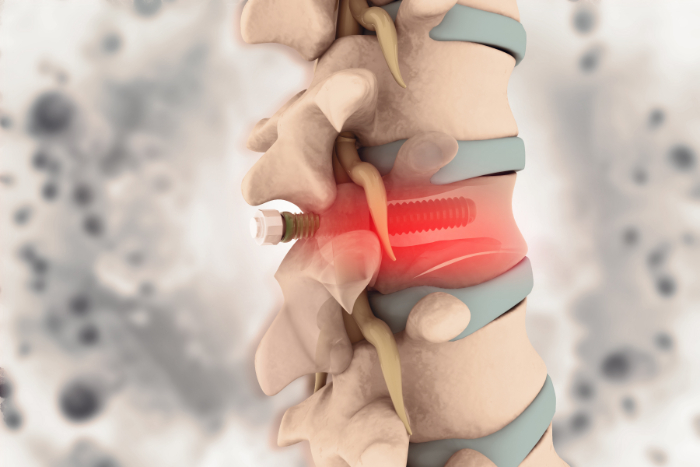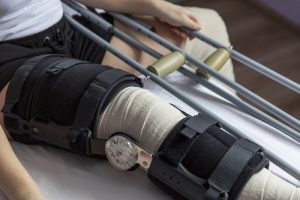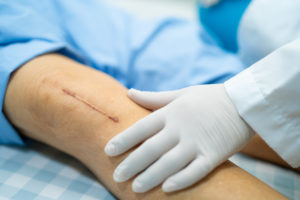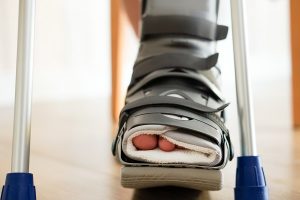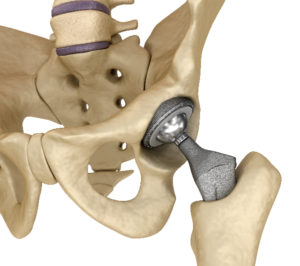Table of Contents
“Step on a crack and you’ll break your back.” Although this phrase is very cliche, one could mistake it as true because it does not take a lot to injure one’s back. Injuries to the back can occur in 3 main ways:
- Traumatic by way of accident (ie: car accident, or a fall)
- Non-traumatic by poor posture and body mechanics
- Pathologic by a disease such as cancer or osteoporosis
Your spine supports your entire skeletal system, and the nerves coming from your spine innervate every part of your body. For this reason, it is very important to protect your back and spine from injury.
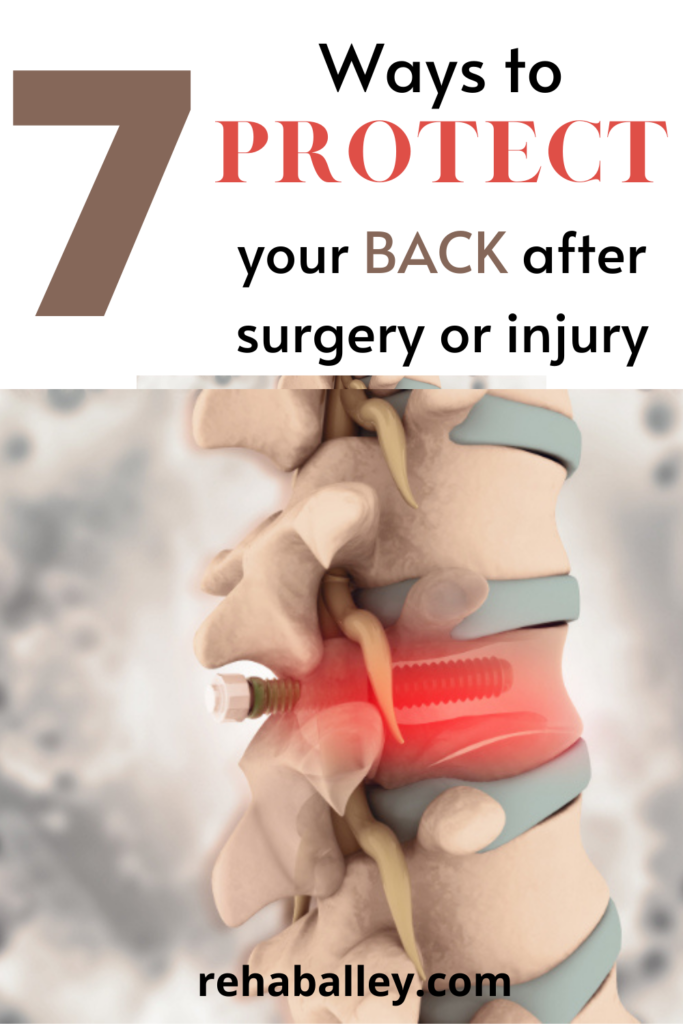
According to an article written by consumer.healthday.com (LINK), about 500,000 Americans undergo surgery each year for low back problems.
In addition, this article points out that according to Johns Hopkins, only 5% of people with back pain are candidates for surgery. This means that most people with back injuries can heal without needing surgical intervention.
Property of rehaballey.com
That is great news, however, in this article, I will not be discussing whether or not you should have surgery. Instead, I will be discussing 7 ways that you can protect your back from injury.
Most of the points that I will be discussing in this blog can be used for people who recently had back surgery, as well as those individuals who wish to avoid back surgery altogether.
These general guidelines can be used in just about any circumstance. Firstly, I would like to provide a brief overview of the different types of back injuries, as well as the different options available. So without further ado, let’s dive in.
Common Back and Spine Injuries
Disc Herniation
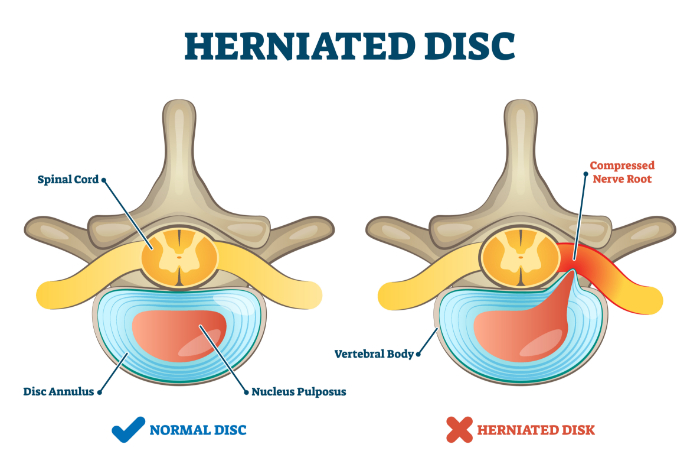
Each vertebra of your spine is separated by a disc that acts as shock absorption for your spine. These discs are made up of 2 parts: an outer cartilaginous layer called the annulus fibrosus, and a gelatinous inner layer called the nucleus pulposus.
Over time with repetitive bending of the spine from poor posture or injury, the nucleus pulposus can leak from the back of the spine, putting pressure on the spinal nerves.
This pressure on the spinal nerves can cause weakness, tingling, numbness, a sensation of pins and needles, radiating pain, and motor coordination deficits depending on which nerves are affected.
Fractures
As mentioned before, fractures can occur from traumatic injuries such as a fall, or pathologic injuries such as osteoporosis. A fracture in the vertebrae or bones of the spine can cause abnormal shifting in the spine.
Fractures can also cause tears in the ligaments or muscles that support the spine. This can lead to back pain, discomfort, and radicular (nerve) pain if the fractured bone is pressing against any nerves. Common fractures of the spine include (LINK):
- Burst fractures– occur when the vertebrae are completely crushed spreading bony fragments throughout the spine.
- Compression fractures– occur when part of the bone collapses due to increased pressure on the spine.
- Dislocation fractures– occur when a vertebra or spine bone slips significantly out of place.
- Flexion-Distraction Fracture– occurs when there is too much bending force on the spine such as with a car accident.
Spinal Stenosis
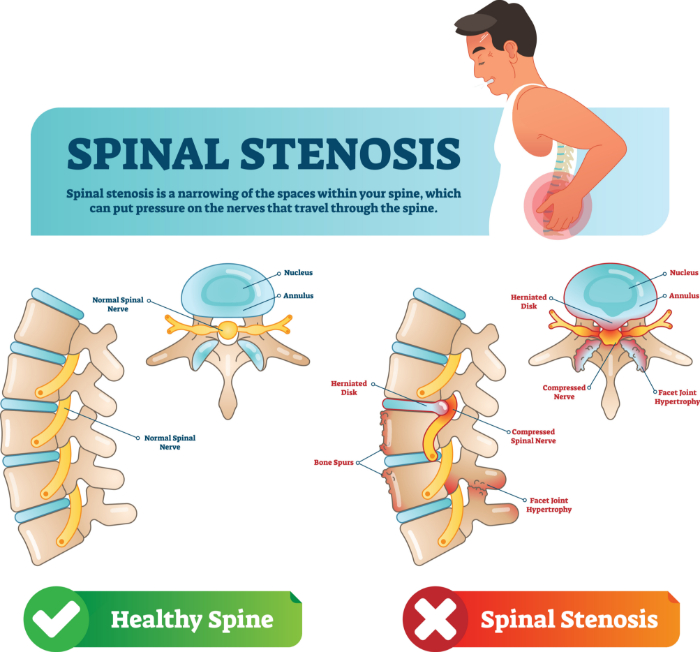
Spinal stenosis occurs when the canals or the foramen (small openings in the spine where nerves exit), become narrow. This can happen either through time with increased age, from an injury such as a fracture, or from inflammation.
Property of rehaballey.com
This narrowing of the spine places pressure on the nerves that exit the foramen. When the spinal nerves become compressed it can cause nerve (radicular) pain such as tingling, numbness, radiating pain, and a sensation of pins and needles.
Spondylolisthesis
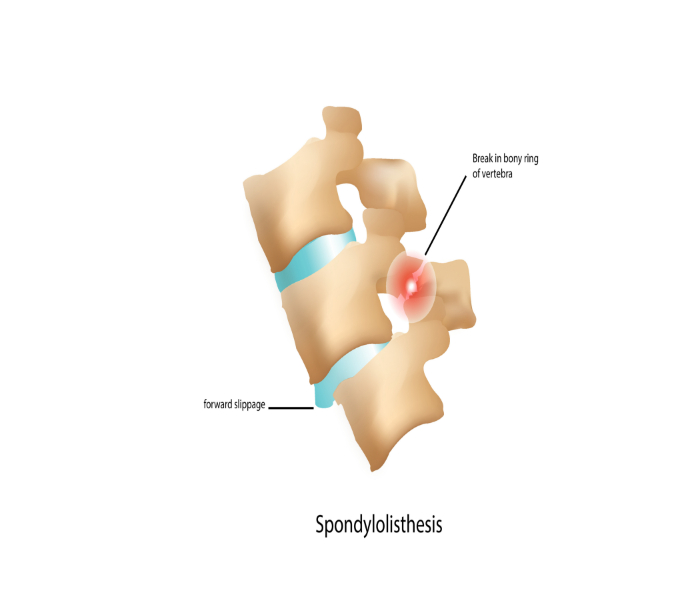
Spondylolisthesis is a condition that occurs when the vertebrae (spinal bone) slips forward out of place. This can either occur from a traumatic or non-traumatic injury. The slipping of a vertebra can also cause compression of the spinal nerves which can lead to radicular (nerve) pain and weakness.
Strains & Sprains
A strain occurs when the ligaments that connect two bones together become overstretched. A sprain, on the other hand, occurs when either tendons (connecting muscles together), or the muscle belly themselves become overstretched.
Both strains and sprains can lead to back pain resulting in tightness, spasms, and swelling. Strains and sprains can be very debilitating depending on the severity and location of the injury. One of the most common causes of strains and sprains is overexertion, however, it can also be caused by poor posture and body mechanics.
Spinal Cord Injury (SCI)
A spinal cord injury can either occur when a spinal vertebra, disc, ligament, or pathology injures the spinal cord, or when an injury or accident is severe enough to directly injure the spinal cord.
Spinal cord injuries can either be complete or incomplete and can affect multiple functions of the body depending on where the spinal cord was injured. Individuals with incomplete spinal cord injuries do have a chance of regaining their function with extensive rehabilitation. This, however, does depend on the severity and location of the injury.
Property of rehaballey.com
Individuals with complete spinal cord injuries have very little if any chance of regaining their function. Spinal cord injuries can lead to paralysis of the upper and lower extremities, issues with bowel and bladder control, as well as issues with the autonomic nervous system that controls blood pressure, heart rate, temperature, etc.
Treatments of Back Injuries
Most back injuries can be treated conservatively using ice packs, gentle stretching, and gentle exercises. NSAIDs or nonsteroidal anti-inflammatory drugs such as ibuprofen can also be used to control pain and inflammation.
Based on the severity, type, and/or location of your injury, your doctor or surgeon may recommend conservative treatment.
**Alley Tips: If your back injury comes from inflammation, it is important to consider your diet and food allergies, many people may not know that certain substances in food such as gluten, sugar, refined carbohydrates, soy, and vegetable oils can lead to inflammatory reactions inside of the body. I will briefly discuss different food choices in later paragraphs**
In some cases, a doctor may recommend surgery especially if the quality of life is extremely affected, or does not improve with conservative treatment.
As stated above, this decision depends on a variety of factors such as the severity of injury, type of injury, location of injury, surrounding tissues affected, and/or age of the individual.
Property of rehaballey.com
Whether surgery is recommended or not, there are general ways to protect your back to promote faster healing and reduce the occurrence of injury.
Protecting Your Back After Surgery or Acute Injury.
#1 Do Not Bend, Twist, or Lift Anything Heavier Than 5-10 pounds.
The universal spine precautions coined “BLT” seek to avoid any twisting, turning, bending, or pressure on the spine.
In other words, you want to think of your spine as being a log. A log is unable to bend or twist, likewise, you want to keep your spine as neutral as possible to avoid injury.
In order to fully achieve this, you may have to use adaptive equipment during your daily tasks. This will be discussed in more detail in the sections below.
**Alley Tips: The doctor or surgeon often places patients on spine precautions after surgery, however, this can also be used for individuals who desire to take a more conservative treatment approach**
#2 Use Proper Mechanics and Posture
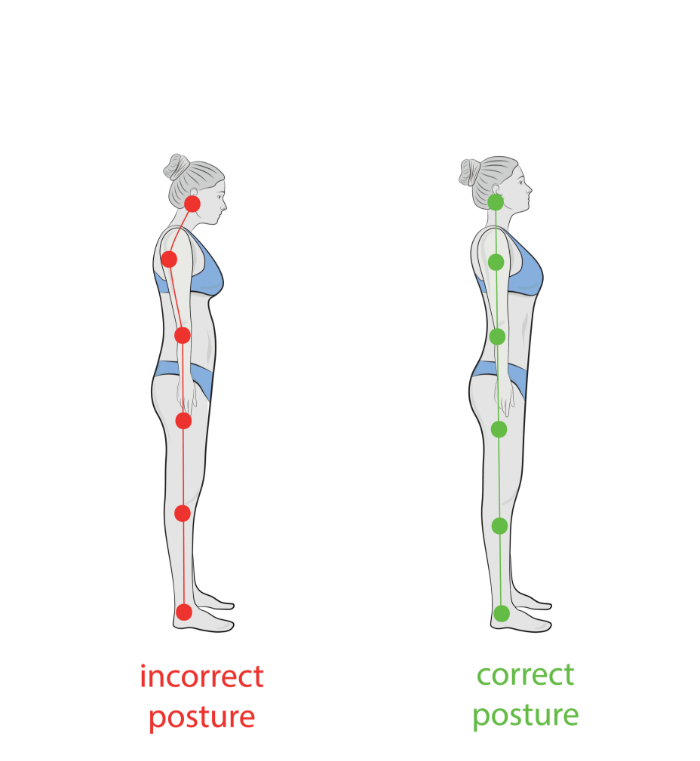
Using proper body mechanics and posture is not only useful after surgery, but can also be used to prevent back injuries from occurring in the first place.
Believe it or not, most non-traumatic injuries that occur in the spine, occur from poor posture and body mechanics that persist over time.
For example, most disc herniations occur from individuals who slump forward while sitting or standing causing the front of the vertebrae to press together. The contents of the disc are released from behind causing a herniation.
Property of rehaballey.com
Therefore, extension or more upright posture of the spine becomes the focus of treatment for people with disc herniations. Maintaining good upright posture during activities can greatly lower the likelihood of developing disc herniations.
Sleep position

Your posture when sleeping matters as well. You want to sleep in a position that supports the natural curvatures of the spine. The best sleeping position for your spine is the supine position (on your back), followed by sleeping on your side, then lastly sleeping in the prone position (on your stomach).
Sleeping on your stomach places the most stress on your spine, so you want to avoid this position.
In addition, I recommend using a pillow under your knees when sleeping on your back, and a pillow between your knees when sleeping on your side for more support. When getting into and out of bed, you want to make sure to roll to your side first before transferring.
#3 Wear a Back Brace if Prescribed
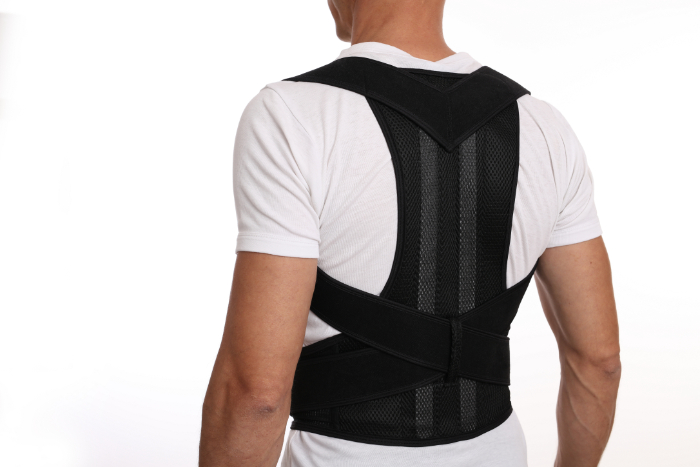
In some cases, a doctor or surgeon will recommend that you wear a back brace when you are out of bed and moving around.
Back braces are used to protect your spine by preventing excess movement of the vertebrae while you are performing certain tasks. It also adds extra support and stability to your spine.
There are many different types of back braces, however, the 2 main types of back braces are LSO (lumbar-sacral orthosis), and TLSO (thoracic lumbar-sacral orthosis). Simply put, an LSO is used for lower back injuries, and a TLSO is used for middle to upper back injuries.
Property of rehaballey.com
Your doctor can determine which brace is better for you based on your injury, surgery, or diagnosis.
**Alley Tips: Back braces are typically prescribed after surgery, although they can be used to support the spine even if surgery is not recommended**
#4 Wear Shoes with Supportive Soles
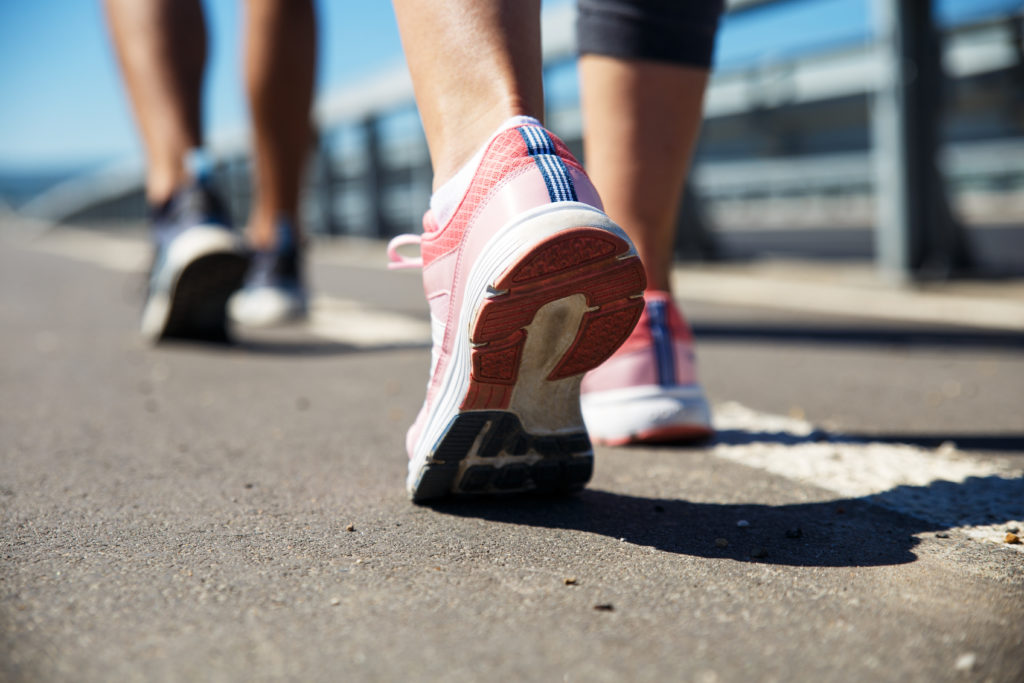
Wearing the proper shoes with supportive soles play an important role in supporting your spine. As mentioned previously, the disc that lay between the vertebrae of your spine acts as a shock absorber for your spine. Well, wearing the proper shoes can reinforce that.
I am not a Podiatrist or a shoe expert, therefore I will not be going into great detail on shoes in this blog, however, there are a few general points to consider.
First, it is important to become aware of the shape of your feet. Some people are overly-pronated and have low arches, and others are overly-supinated and have high arches.
In addition, some individuals may have a leg length discrepancy and require higher supports on one foot in order to keep their pelvis and spine in good alignment.
In general, you will want to purchase shoes that support your arches and entire foot. When walking, I usually tell my patients to wear either tennis shoes or sneakers with medium-sized soles and good treads.
Property of rehaballey.com
Stay away from slippers, sandals, and even socks as they provide minimal to no support for your feet.
Most people fail to realize that their bodies work as a chain. Have you ever heard the saying “Your hip bone’s connected to your….knee bone etc?” Well, it is true.
Spine dysfunction can be a result of issues in the foot, ankle, knee, or hip. So wearing supportive shoes is key to reducing pain and injury in the back.
For shoes designed to fit your needs, I recommend Orthofeet. Orthofeet provides comfortable and biomechanically designed shoes to support a variety of foot ailments and injuries such as neuropathy, arthritis, diabetes, plantar fasciitis, calluses, Achilles tendonitis, edema, etc.
In addition, Orthofeet also provides additional footwear and foot supports such as compression socks, insoles, hands-free shoes, and much more. Click HERE for additional information on Orthofeet shoes.
#5 Perform Gentle Exercises as Prescribed
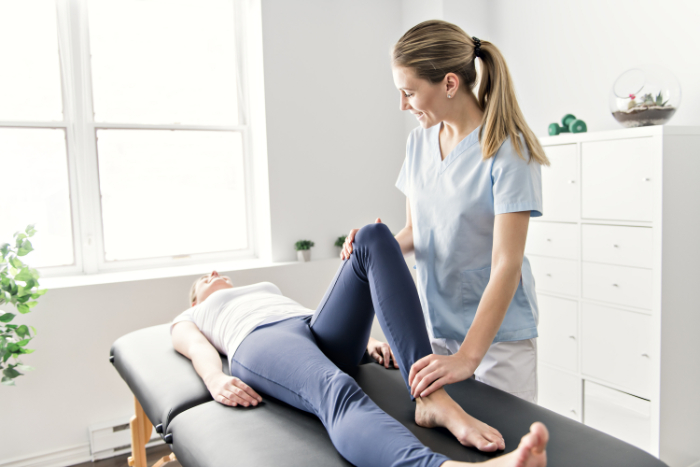
Performing gentle exercises prescribed by a doctor or therapist is also key to reducing injury and strengthening your back. There are numerous muscles in your back, large and small, that play different roles in either mobilizing or stabilizing your spine.
The smaller, more intricate muscles of your spine are most important in providing stability to your spine. The majority of the exercises prescribed during the early stages of healing and injury are going to be geared toward promoting the stability of your spine.
Core stability plays an important role in stabilizing your spine as well. The more support you have, the more stable your spine will be. Listed below are a few general exercises that help strengthen your back:
- Abdominal sets– Lay on your back and press your belly button down towards your spine.
- Supine marches– Lay on your back, bend your knees and press your belly button down toward your spine. Lift one leg halfway toward your chest, place it down, and repeat on the other side.
- Dead bugs– Lay on your back, bend your knees, and press your belly button down toward your spine. Lift one leg halfway toward your chest, then repeat on the other side. Then place the first leg back down, and repeat on the other side.
- Heel slides– Lay on your back, bend your knees, and press your belly button down toward your spine. Slide one leg down then back up, repeat on the other side.
**Alley Tips: It is important to note that the exercises listed above are general exercises for people with an acute injury to their back. Always speak with a doctor or consult your therapist for more specific exercises pertaining to your needs**
#6 Use Adaptive Equipment or a Mobility Device
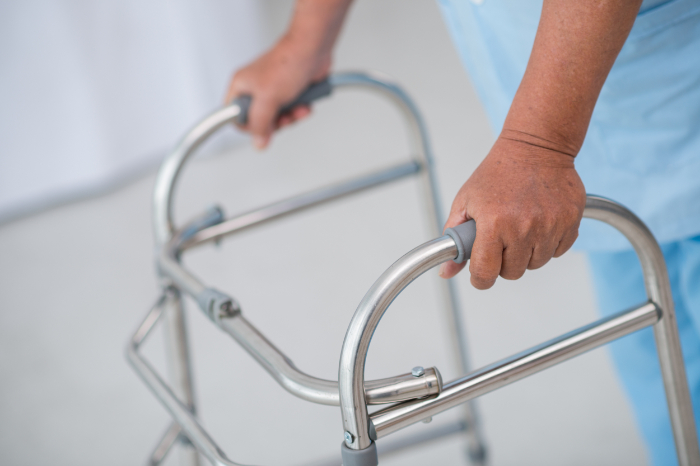
Using adaptive equipment or an assistive device is very important especially after surgery, or during the early stages of injury. As mentioned previously, bending, lifting heavier than 5-10 pounds, or twisting your spine will be prohibited.
As you can already imagine, this makes it very difficult to get dressed, take a shower, and perform other daily tasks. For this reason, you will need to purchase adaptive equipment.
Listed below are adaptive equipment that I recommend for use after back surgery or injury:
- Shoehorn (LINK)
- Sock aide (LINK)
- Shower sponge (LINK)
- Removable shower head (LINK)
- Transfer-tub bench for bathtubs (LINK)
- Shower chair for stand-up showers (LINK)
- Reacher (LINK)
- Elastic shoelaces (LINK)
I also recommend that you use a mobility device. After spinal injury or surgery, it is very likely that your strength and balance will be compromised.
Property of rehaballey.com
An assistive device will not only help reduce extra stress and strain on your back, but it will also provide additional support until you regain your strength and balance. Below is a list of assistive devices that I typically recommend for my patients:
- Rolling walker (LINK)
- Cane (LINK)
- Wheelchair recommended for individuals who are unable to walk, or individuals who are unable to tolerate walking for long distances (LINK)
#7 Reduce Inflammation

Because your spine has been injured, you will have some inflammation that occurs. Inflammation is the body’s natural way of healing injuries and dealing with illnesses.
Through inflammation, the immune response is activated. This in turn, can lead to increased pain and swelling in the surrounding areas. It is very important to control this inflammation, as it can inhibit your functional mobility and increase your pain.
One of the most common ways to reduce inflammation is to use ice packs. I recommend 15-20 minutes of ice every 2 hours. NSAIDs may also be helpful in reducing pain and inflammation however, consult with your doctor first as NSAIDs may not be appropriate for everyone.
Property of rehaballey.com
Lastly, you always want to make sure that you are eating an anti-inflammatory diet. Improving your diet is probably the single most important thing you can do to reduce inflammation in your body. A person’s diet is often overlooked and is very rarely discussed in the doctor’s office.
I find it interesting, however, because most inflammatory diseases can be traced back to a poor, western-style diet. A low-carb, ketogenic-style diet, for example, has been proven countless times to reduce the harmful effects of inflammation in the body.
Keeping your diet as clean and natural as possible, such as with the Paleo diet will help as well. The key is to get rid of processed foods and stick to more whole foods. Listed below are examples of inflammatory and anti-inflammatory foods:
| Inflammatory Foods | Anti-inflammatory Foods |
|---|---|
| Sugar/Alternative Sweeteners | Dates, Honey, Maple Syrup |
| Wheat-gluten | Fish, Salmon |
| Refined carbs and grains | Organic Fruits and Vegetables |
| Processed foods/fast foods/fats | Avocados and other monounsaturated fats |
| Vegetable oils/cooking oils | Water/steam, vegetable broth |
| Soy, corn, and other subsidized products | nuts/seeds (moderation) |
| Table salt | Herbs- ginger, garlic, turmeric, cinnamon |
| Heavily processed meats | Low-processed meats/poultry (grass-fed) |
| Sodas/processed juice | Decaffeinated tea, natural juice from fruit |
Hopefully, this article gives you a better understanding of how to protect your back after a recent injury or surgery. Feel free to visit my website at rehaballey.com/blog (LINK) for more information on how you can stay healthy and functioning at your optimal potential.
In addition, please refer to my contact page (LINK)for advice, or for any questions that you may have. GOD BLESS YOUR ENDEAVORS!!
**This blog contains affiliate links, refer to our disclaimer page (LINK) for more details**

